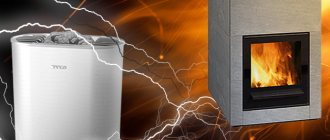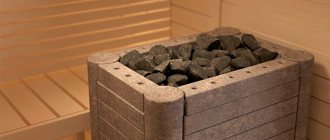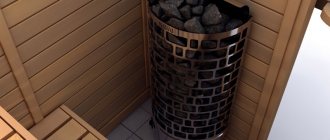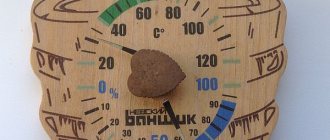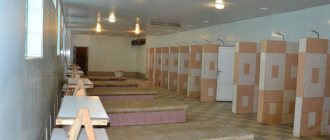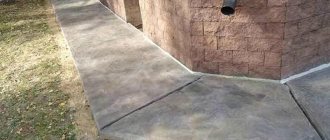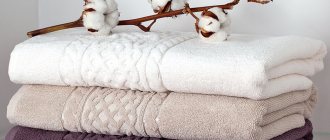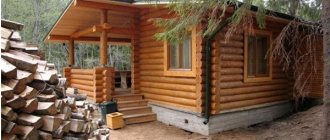Progress is such a capricious young man who constantly encourages the owners of country houses to improve their furnishings and compete with their neighbors in the same baths and saunas. Progress has led to the fact that today the old cast-iron heaters and primitive brickwork have been almost completely replaced by the electric sauna stove. And this is not bad, because these units have a number of advantages, although there are also specific features. All this will be discussed below.
Connecting an electric stove in a sauna
The size of the stove is chosen depending on the size of the sauna room.
In this regard, the choice is truly enormous. For a “baby” sauna (these are often installed in apartments), you can buy a triangular-shaped electric heater: installing it in a corner saves space. Another convenience is that the corner heater can be hung on brackets (fasteners are included in the kit). True, a “suspended state” is possible for small heaters of different shapes. Even small electric sauna stoves have enough power to heat rooms much larger than “cabins.” That is, the power in them is provided with a reserve. But, nevertheless, when planning to buy a heater, you need to focus, first of all, on the size of the sauna. The accompanying documents always indicate the volume of the room that it can heat.
Keep in mind: a voltage of 220 V is sufficient for a sauna stove with a power of up to 6 kW; more serious electric heaters require a voltage of 380 V and three phases.
I want more articles:
| Leave your review | |
| Send Reset |
Average rating: 0 reviews
But it won’t be a matter of choice, you just need to get a sufficient understanding of what a sauna stove is, what types the market offers, and how to take into account the features of an existing steam room when purchasing. We will try to provide comprehensive information on each of the points.
The voltage in a regular household electrical network is 220 volts. Therefore, most buyers are interested in their furnace operating from such a network. This would save them additional hassle and expense.
However, in practice, the voltage consumed is directly dependent on the power of the purchased unit. And the power, in turn, depends on the volume of the heated room. It follows from this that the owner of a large family or family-guest sauna does not have to count on cutting costs - a large stove will need a 380-volt network.
IMPORTANT! Typically, sauna stoves that consume 220 volts have a power of no more than 7 kW. This is enough for a small and even medium-sized steam room.
Electric heater SAWO MINI MN-23NB-Z. Photo by SAWO
You can bring 380 volts into a house or apartment - it’s not particularly difficult, you just need to take three instead of one phase. Difficulties arise with permits and with replacing wiring (it must be thicker than usual). Well, don’t forget that you will have to pay more for electricity bills, but this does not depend on the network itself, but on energy consumption.
By the way, you can easily install a three-phase 380 volt network in private homes - not everyone knows, but this issue is resolved at the request of the consumer.
Electric sauna heaters 220 volts – Helo CUP 45 ST, Sawo Mini MN-23 NB-Z, Harvia Vega Compact BC 23, Tylo Compact 2/4, Polytech-M PEN-2m.
Electric sauna heaters 380 volts – EOS 34 A, Harvia Virta HL 90, Tylo SD 20, Helo Seidankivi Seita 1052, Polytech “Christina” with ENU-18i evaporator.
Keep in mind! In the characteristics of some furnaces there is a mention of the possibility of connecting to both single-phase and three-phase networks - “220/380”.
Electric sauna stove Harvia Trendi KIP (220v and 380v)
Another interesting point: do you need a stove with a steam generator in a sauna? After all, a sauna is called a “dry air bath” for a reason – there is little steam in it, the main “ingredient” is dry heat, which makes a person sweat (and convection is responsible for evaporation). How will he sweat if the humidity in the bathhouse increases?
Do you know, for example, why in Japan at 30 degrees the heat is considered unbearable, but in continental Asia even at 50 degrees people continue to calmly go to work? Because high humidity does not allow sweat to evaporate from the surface of the body, and it does not cool it (continental air is much drier than island air). The result is overheating, heart problems and other related ones.
IMPORTANT! You need to be careful with the steam generator in the sauna. Lower the temperature if you want more steam. And for an ordinary sauna, the steam produced by a regular heater, which is available in all electric models, is quite suitable.
However, sometimes a steam generator is necessary. For example, when we are talking about a heater that can operate in the “sauna” and “Russian bath” modes. Of course, it will be a surrogate, but it will be fast. The heater will almost instantly heat the bath to 60 degrees, and the steam generator will produce (if it can) fine steam.
BY THE WAY! Couples are different. There is a low-temperature one - you usually see it above pots and kettles. It is white and thick, and heavy on the body. There is superheated steam - it is almost invisible, it is light, and this is what your steam generator should be able to produce.
Steam generators are also different: built-in and separate. Here are some models.
Steam generator Helo HNS 34 T1
Individual:
- Sawo STP-90-C1/3 SST,
- Harvia HELIX HGX 2,
- Helo HNS 34 T1,
- Tylo Steam 2/4/6 VB,
- HygroMatik CompactLine C06-CDS,
- Sturm Etna 3 Pietra,
- EOS SteamTec Classic.
Built-in: all models with the word Combi in the name.
A mini-sauna is a very small room (from 1.5 cubic meters), designed for one or two people steaming at the same time. Recently, it has become fashionable to arrange these right in city apartments.
Pleasant things are combined with useful things. A mini-sauna does not consume much electricity, and you can even make it yourself. The main thing is to take good care of thermal insulation.
Sawo – Mini and Mini-X series (see photo above). Harvia – Vega Compact, Delta, etc.
Harvia Delta D23 oven. Harvia Photos
Who is considered the best manufacturer of sauna stoves? Of course, those who understand the intricacies of this bathhouse better than others. And in this regard, the Finns have practically no competitors - this is their national pride, which they are happy to export to the whole world. But exporting is always expensive.
Well, of course, the ovens themselves are not belt or tubular. We are talking only about the design of the heating elements, which can be either in the form of tubes or in the form of a ceramic tape. Tubular shells are usually made of metal.
Tubular heater
IMPORTANT! Tubular electric heaters are quite fragile and easily fail. They can be damaged by stones that are placed too tightly (when heated, the stone expands), or simply by a random movement that bends the heating element at the base. See article
about the correct placement of stones in an electric heater
.
Today, most electric heaters are equipped with tubular elements. The reason may also be a reduction in cost. But this is not the best option for the consumer. They are not as economical as tape ones. The latter also burn less oxygen!
Electric sauna stove, strip. Photo source
On a note! When calculating power, take into account that strip elements with equal power heat one and a half times the volume.
Useful video
Well, we looked at a number of models based on various criteria. It would be a good idea to bring the information together to make it easier for the reader to make their choice. Therefore, we decided to invite users to take part in compiling a rating, this time of electric sauna stoves.
For our part, we have selected a list of the most popular manufacturers, because it is important to know who you can trust, and the parameters of the steam room and the needs of all consumers are different, it is not possible to take them all into account. But with our joint efforts we can easily help beginners with their choice.
Loading …
Now is the time to move on to practical issues. Let's start with those that are asked by those sauna owners who have already decided to buy an electric heater. They need to know how to choose a stove with the right parameters.
Of course, an electric heater is not nearly as demanding as a wood-burning (and even more so a brick) stove. It does not need either a foundation or a chimney; many models can be mounted on the wall, and some can even be hung from the ceiling! However, some preparation is still necessary.
For your information! Did you know that some heater models can be installed directly into the bottom shelf? This significantly saves space, and the shelf is protected by a special flange made of steel or other material, which can be purchased along with the stove.
Where the heater will stand, it is better to lay out the floor with tiles or otherwise make it non-flammable (put a sheet of metal, for example). A suspended structure does not need this.
You will find the minimum distances to the main surfaces in the stove data sheet. Usually they are small, but they should be observed exactly or upward.
But if practically no questions arise regarding the installation of the furnace itself, then the same cannot be said about its connection.
The fact is that each sauna owner must independently take care of grounding the purchased unit. If you are not particularly versed in electrics, then entrust the connection to professionals, it is worth it.
It was already mentioned above that electric heaters come with different voltages. For those that can be connected to a regular network, nothing needs to be changed in the wiring. But for those with a voltage of 380, you already need to install a cable of the appropriate quality and thickness.
So, grounding. It is better to make its circuit separate for the sauna, rather than using the circuit of the distribution panel. This is not so difficult - the Internet is full of information on how to make a ground loop yourself. It is preferable to conduct the core through cable channels.
In addition, we can recommend connecting the stove to the network not directly, but through a device that ensures that the electrical appliance is turned off if a short circuit occurs or the air in the steam room gets too hot. Such a device will not be needed if a differential circuit breaker with a leakage current of 30 mA is installed.
Advantages of these ovens
Statistics confirm that sales of electric stoves exceed those of wood-burning heaters by 2 times. And there are a number of explanations for this:
- Small dimensions and convenient weight: such a sauna stove can be placed at the owner’s request in any corner, can be moved and can be easily washed and cleaned.
- The most important advantage is that for an electric-powered stove there is no need to install a chimney. And in general, the installation process is reduced to zero - except to ensure that there is an outlet nearby and additionally check the insulation of the electrical wiring.
- It only takes a few minutes to light a steam room equipped with such a convenient stove: turn it on and forget it, as they say, you can go about your business.
- Whatever you say about the benefits and aesthetics of wood-burning stoves with natural flames, they add risks. Firstly, a spark may escape and create a fire. And secondly, the floor around the electric furnace is always clean and not damaged by coals.
- The electric oven allows you to select the voltage supply mode - single-phase 220V or three-phase 380V. Which is important when redistributing energy in the house and on the site.
(See also: Ermak sauna stoves)
(See also: Do-it-yourself oven in the yard)
In a word, simple and easy to maintain, these units open up many possibilities in management. For example, practicality and always well-groomed appearance, remote start using a remote control or by pressing one button on the control panel. Modern stoves completely eliminate the possibility of short circuits and are protected against overheating and voltage surges in the network. Individual samples can even recognize a comfortable temperature and maintain it at the same level, accumulating thermal energy. As a result, any room warms up evenly and quickly, which is especially appreciated in the construction of public and municipal fitness centers, baths and steam rooms.
Cost of heating with electricity in a house
The most expensive expense item in a private home is the cost of heating with electricity, if you have heating with an electric boiler. With the cost of 1 kilowatt per hour around 3 rubles, let’s calculate how much it will cost.
For simplicity, let’s calculate the area of the house as 100 square meters. And then everyone will be able to calculate how much it will cost him to heat his house with a specific area.
While there is no gas and you heat with electricity? Prepare 50-60 thousand rubles for the heating season for a house of 100 sq.m.
For every 10 square meters of a well-insulated house, you will need 1 kilowatt of electric boiler power. For 100 square meters you will need a boiler with a capacity of at least 10 kilowatts.
Electricity consumption for heating with such a boiler power will be 10 kilowatts per hour in cold weather - the boiler will operate continuously. Total 240 kilowatt-hours per day. If you have frosts below -30C for a month, then your electric boiler will consume 7200 kilowatt-hours of electricity. Isn't it weak? More than 7 megawatts per month! Which will cost you more than 20 thousand rubles just to heat your home.
However, in practice, such frosts occur in central Russia and even in the Urals for no more than 1-2 weeks during the winter. Sometimes, in some winters, however, there are prolonged frosty periods, as, for example, in the winter of 2013.
The rest of the time, when winter temperatures fluctuate at -15C -20C, the boiler operates half the time. That is, your approximate cost of heating a house of 100 square meters will be equal to 10 thousand rubles per month.
These are the winter months - December, January and February. In November and March, the boiler will operate only 8 hours a day at full capacity, or gradually consume only a third of the electricity. This means that in November and March your electricity costs for heating your house will be approximately 6-7 thousand rubles.
In October and April, the cost of heating with electricity will be completely insignificant - 2-3 thousand rubles.
To summarize, the total cost of heating a well-insulated house with an area of 100 square meters in central Russia and the Urals will be 50-60 thousand rubles for the entire heating season. And the practice of heating with electricity confirms this.
Of course, if you have gas or heat your house with a solid fuel boiler, then you can omit these calculations.
How much electricity does an average boiler consume?
The water heater is accompanied by technical documentation, which indicates all equipment values. To calculate electricity, we take the average value. To do this you will need the following values:
- The number of kilowatts that the water heater consumes while heating and maintaining the water temperature;
- The volume of hot water consumed per day in liters or cubic meters.
Let's consider an example for a boiler with a volume of 50 liters. First of all, you should determine how long it takes to heat up the water in the water heater. The minimum temperature is usually 70°C. It takes approximately 2 hours to heat the water to the desired temperature. To maintain a comfortable temperature, the heating cycle occurs 2 times a day for 2 hours. The technical documentation indicates electricity consumption during operating mode: 2 kW per hour. Based on the calculation, we get 4 kW per day.
In addition, do not forget about the “Heating” mode. 4 kW needs to be divided by the number of hours that are not involved in heating water. Thus, 4 kW/12 = 0.3 kW per day. The total amount of electricity consumed by a 50 liter boiler: 4+0.3 = 4.3 kW. 129 kW is consumed in 30 days. To calculate the cost of payment, you need to know the tariffs for each region.
Cost of lighting in a private house
If you install energy-saving lamps with an average power of 13-15 watts in all the lamps in your home, which is equivalent to a regular lamp of 75 watts, then your costs for lighting your home will be within very reasonable limits.
In winter, lighting operates for 10 hours a day, and in summer – for 3-5 hours, excluding external lighting. Of course, if external lighting is installed correctly and equipped with light and motion sensors, then external lighting will work no more than internal lighting.
Modern sensors make home and garden lighting efficient and cost-effective.
So, you have a house of 100 sq.m., in which you have approximately 20 lamps with a power of 15 watts. That's only 300 watts per hour. With an average lighting time of 7 hours (both in winter and summer), this is only 2 kilowatts per day or 60 kilowatts per month.
That is, the cost of lighting in a private house of 100 square meters will amount to no more than 200 rubles per month.
The heating system circulation pump, boiler automation, VOC compressors, televisions, satellite receiver, computers, gate drives, washing machine, phone chargers - all these are consumers of electricity in a private home. And they all require kilowatts, although not much. It will cost you approximately 200 to 300 rubles per month to maintain these devices.
How to save on energy consumption?
According to the Decree of the Government of the Russian Federation dated December 31, 2009 No. 1222 (as amended on December 30, 2011) “On the types and characteristics of goods, information about the energy efficiency class of which must be contained in the technical documentation attached to these goods, in their markings, on their labels , and the principles of the rules for determining the energy efficiency class of a product by manufacturers and importers” the energy saving class must be indicated
The list of these goods includes mainly household appliances:
- freezers,
- refrigerators,
- washing machines, including those with and without a manual spin device,
- dishwashers,
- air conditioners (split systems),
- electric stoves and electric ovens,
- microwaves,
- TVs,
- electrical appliances for heating and heating liquids (boilers, water heaters),
- incandescent lamps,
- monitors,
- printers.
Today there are many options for saving energy. These methods are not at all complicated, but for them to work you need to use them every day. Reducing energy consumption will not only save the family budget, but will also reduce emissions into the environment.
- Use of energy-saving light bulbs. Such lamps practically do not heat up, so electricity is spent only on lighting. On average, the service life of such lamps is up to 3 years, and this will significantly save costs. Such lamps consume 5 times less electricity, their service life is 10 times longer and pay for themselves in 1 year.
- When using household appliances, it is important to follow the instructions. Let's take the refrigerator for example. It cannot be placed near a stove or radiator, as the device will need to work uninterruptedly to maintain the required temperature. The same applies to the moment when hot food is placed. It is important not to forget to defrost the refrigerator in a timely manner, since ice in the freezer contributes to high energy costs (up to 20%).
- When leaving the room, do not forget to turn off the lights. This advice is the most effective way to save energy.
- Clean light bulbs regularly. At first glance, such advice seems ridiculous. But few people know that dust can block up to 15% of the light. It is important not to forget about the cleanliness of the lampshades. You can use lower wattage lamps.
- Make some minor cosmetic repairs to the room. When choosing wallpaper, you should pay attention to light shades, as they can make the room 80% brighter and more comfortable. We should not forget about the ceiling; it should be made white. This way you will turn on the lights less often.
- Application of heat-reflecting screens. They are made from foil or foam foam. They should be installed behind the battery. Thanks to such screens, the temperature in the room can be raised by several degrees.
- Insulation of the room. It is necessary to insulate the windows or replace them with metal-plastic ones. Up to 30% of heat can be lost through windows. You should hang thick curtains on the windows. If possible, you need to insulate the entrance doors, as well as the walls, ceilings, floors and roofs of the house.
- Purchasing household appliances of class “A”, “A” and “A”, they can save up to 50% of electricity.
- It is not recommended to leave devices in “standby” mode. A person uses any technology for only a few hours during the day. The rest of the time it is in “standby” mode and gradually absorbs electricity. To save money, devices should be turned off from the network.
And so, we already know how many kilowatts are needed for a home. Let's summarize. From what was described above, it follows that if we use electricity sparingly, then we can easily invest in 15 kW, and for a small house this is even enough for heating. Then the whole family will feel comfortable in their cozy nest.
Power calculation
It is easier to calculate the power of an electric stove than a wood stove. The manufacturer indicates the power in kilowatts in the passport. The consumer can only determine the volume of his steam room in order to get his bearings. But! There is a formal volume, and there is an adjusted volume after adding coefficients - for example, for surfaces without thermal insulation, for heating adjacent rooms in winter, etc.
So, tiles, glass, stone - you need to calculate their surface area, multiply by 1.2 and add to the formal volume.
We count the glass door to the steam room separately - just add an extra one and a half cubes to the existing numbers.
Then it’s simple: for one kilowatt of stove power – one cubic meter of steam room space if the stove has heating elements, and one and a half cubic meters if there are tape heaters.
I want more articles:
Operation of electric stoves
An electric stove is one of the most wasteful electrical appliances in modern life. An ordinary family of 4 people living in a standard city apartment with an electric stove consumes at least 2000 kW*hours of electricity during the year. At the same time, tiles alone, working on average 1400 hours a year, consume from 1100 to 1400 kW*hours of electricity. Accordingly, you can calculate how much the stove consumes per month - from 90 to 120 kW. However, with proper operation of the device, these costs can be significantly reduced.
Connecting the electric stove to AC power
A household electric stove is a source of increased danger, therefore, when connecting it to a 220 V power supply, you must ensure that:
- input circuit breaker and power socket designed for a current of at least 32 A;
- residual current device, which is controlled by residual (differential) current.
The connection of all these devices must be carried out with an electric cable consisting of three cores with copper conductors, with a cross-section of at least 4 mm2 each. In this case, the cable must be double insulated, and all connections must be made in such a way as to prevent overheating of the contacts.
Important! Work on connecting an electric stove must be carried out in compliance with all safety requirements specific to electrical installation work. This will prevent electric shock when operating the stove.
Saving energy when working with an electric stove
Electricity consumption during operation of the stove depends not so much on its technical characteristics as on the conditions of use. For example, there is no need to cook food using the full power of the burners. It is enough to bring the contents of the pan to a boil, and then reduce the heating power to a minimum. After all, it is impossible to heat food above 100°C, and intense boiling and evaporation of liquid will lead to a loss of approximately six hundred watts (W) of electricity per liter (with the lid open). Products that need to be cooked for a long time are cooked on a small burner and at minimum power.
In general, cooking food on a low-intensity hotplate saves a lot of energy. Therefore, the stoves are equipped with special power regulators, which can reduce electricity consumption by up to 20%. This is especially true for stepless regulators, which allow you to smoothly change the power of the heaters from 4 to 100%. There are also electric stoves in which the power is controlled automatically and depends on the temperature of the bottom of the cookware installed on the burner.
When operating an electric stove, it is advisable to use special cookware that has a thick, flat bottom that fits tightly to the burner. This improves the transfer of heat from the surface of the oven to the pots and pans. It is also advisable to use cookware with bottom dimensions equal to or slightly larger than the dimensions of the burner. This will also help you save up to 20% energy.
Advice! Cooking on faulty burners increases electricity consumption by 2 to 6%. If one or two spirals fail, the minimum power can increase several times. And cracking and swelling of the burner impairs heat transfer, which also does not help save energy.
Induction electric stoves
An induction cooker is one of the new trends in electric cooking surfaces, which has a number of advantages over conventional electric cookers. The main advantage is significant energy savings during operation, which is achieved due to:
- fast heating;
- automatic shutdown of the heater when removing dishes from the hob;
- effective control of cooking temperatures, etc.
The operating principle of an induction cooker is to use an electromagnetic field generated in an inductor. This heating method is more economical, since the heat is transferred directly to the cookware, bypassing intermediate elements (burners, surface). But there is a significant caveat: the bottom of the kitchen utensils in which food will be cooked must be made of ferromagnetic material.
Cost of electricity in the kitchen
If you don't have gas, you'll have to cook with electricity. Modern electric stoves are highly efficient, but they also consume 5 to 7 kilowatts of electricity per hour at full power.
A modern kitchen, even with a powerful stove, does not consume much electricity.
The approximate cost of cooking with electricity will be from 300 to 500 rubles per month, regardless of the size of your home.
Fridge.
The energy consumption of refrigerators is calculated over 365 days for a 220V/50Hz network. Designed for 100 liters of useful volume per day, it allows you to compare refrigerators of different sizes. Again, the amount of power consumed depends on the volume of the refrigerator and the amount of food stored in it.
External conditions also leave their mark, changing depending on the time of year. The technical data sheet for the refrigerator indicates the energy consumption per year. In most cases, this figure ranges from 230 to 450 kW/h. By simple calculations, dividing this figure by 12 months, we get from 20 to 40 kW/h. Again, this number only applies under ideal conditions. In reality, it is unlikely that this value will be achieved.
Dimensions
The smaller the sauna, the more important the size of the stove becomes. Low-power heaters are usually very modest in size. An example is the Harvia Compact stove - its width is 24.5-30 cm, depth 22 cm, height 54 cm. It weighs only 9 kg (without stones). Another model from the same company - Vega Compact - weighs even less: 7 kg and has dimensions: 28x29.5x50.5 cm.
IMPORTANT! Information on sizes is essential for selection, therefore it is always indicated in catalogs.
Yes, and one more interesting point: ovens of the same size (within the same line) can have different power. This allows the manufacturer to reduce production costs, and the consumer to choose a standard-sized heater for the volume of the steam room.
Further information will be useful to those who have already purchased a stove and need information on how to properly install and connect it.
Appearance and cladding
The sea of models offered on the market differ in size, interface, and variations of facing material. And even the placement method: you can install the electric oven in the corner of the room or hang it on the wall using mounting brackets. Or you can make an electric oven the central element of the room. In this case, finishing will play an important role.
Some manufacturers offer a sauna stove-fireplace lined with natural stone. In addition to aesthetics, this solution also has a protective function. For example, a coil or talc-containing rocks absorb the radiation of infrared rays and control temperature changes. They also carry an additional load, accumulating thermal energy and releasing it to the room during the cooling process of the furnace.
Although you don’t have to spend money on such a shocking look, if you are going to place the stove further away in the corner, choose simple stainless steel models. At the same time, you will save almost 50% of the cost, which is important if the stove is chosen for a public steam room for commercial gain. Moreover, the stones are already laid in the heater.
Connecting an electric stove in a sauna
IMPORTANT! The remote control needs a circuit breaker in the distribution panel. Look at the stove data sheet to find out the current load. In accordance with it, the denomination of the machine is selected.
Electric furnace sensors allow you to monitor and control the heat. They also require installation, but all its points must be described in detail in the installation instructions for your stove.
IMPORTANT! Do not use intermediate connections, or extend or twist sensor wires.
A separate question is what wires can be used to connect the electric heater. If the stove is designed for 220 volts, then the wires will be three-wire, if for 380 - five-wire. An important issue is the sheath of such wires. The fact is that vinyl is in no way suitable for your purposes. It is correct to use rubber-insulated wiring that is not afraid of high temperatures.
***So, we will consider that the short course for the future owner of an electric heater is completed. I wish you health and a pleasant stay in your own sauna!
Are there any disadvantages?
Of course, stoves for baths and saunas based on electric heating elements do not meet such high parameters of environmental friendliness and health benefits as wood-burning heaters do. There won't be any harm, of course. But the beneficial resins released during the wood burning process will not enter the air. Some owners complain that the air in the sauna is dry when using an electric stove, but this is easy to fix. (See also: Electric hot water boilers: advantages, disadvantages and types)
If we compare wood-burning and electric heaters further, then the first one is not tied to a power source and can be heated even in the absence of electricity. Wood-burning stoves have a greater output of thermal energy, because during prolonged heating, cast iron, brick or other materials take on the heat transfer, accumulate and build up heat. Of course, an electric furnace cannot be used to heat water in a bathhouse, having, in principle, less power. But all this cannot be called a direct disadvantage; rather, it is a cost of the system, which owners must be prepared for.
What affects the power of an electric oven?
It is also worth considering the fact that built-in appliances always consume more energy than free-standing appliances. The average built-in oven will use 4,000 watts, while a freestanding oven will use around 3,000 watts.
Are these indicators really that important or is their importance overestimated? In fact, a lot depends on the power of the stove. For example:
- The amount of electricity consumed directly depends on the power: the more powerful the oven, the less electricity is consumed.
- An oven with a higher power will cook much faster than a less powerful oven.
- Spending on light becomes noticeably less.
Thus, knowing how much energy a particular electric oven consumes, you can choose the best option for yourself so that the oven becomes a real helper in the kitchen, without extra costs for electricity.
Safe operation and alternative solutions
To use the oven safely, the resistance force must be taken into account. To do this, you need a device passport, thanks to which you can calculate the furnace power using a calculator. The amount of energy consumed must be divided by the average voltage in the outlet, that is, by 220. In this way, the required power of electricity is calculated at which the oven will work properly.
It is important to take into account the fact that when using gas heating, the use of an oven with an energy consumption of more than 3500 W is strictly prohibited. This ban was imposed based on the average power of wiring in apartment buildings. Using devices with a power higher than permitted can lead to voltage surges and a short circuit in the network.
A combination stove is an excellent option if it is impossible to install a more powerful device.
In this case, a way out of the situation may be to install a gas or combined stove, which consumes much less electricity.
